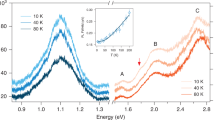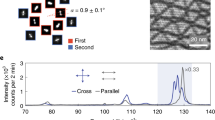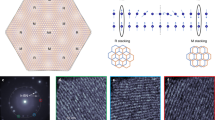Abstract
Layered antiferromagnetism is the spatial arrangement of ferromagnetic layers with antiferromagnetic interlayer coupling. The van der Waals magnet chromium triiodide (CrI3) has been shown to be a layered antiferromagnetic insulator in its few-layer form1, opening up opportunities for various functionalities2,3,4,5,6,7 in electronic and optical devices. Here we report an emergent nonreciprocal second-order nonlinear optical effect in bilayer CrI3. The observed second-harmonic generation (SHG; a nonlinear optical process that converts two photons of the same frequency into one photon of twice the fundamental frequency) is several orders of magnitude larger than known magnetization-induced SHG8,9,10,11 and comparable to the SHG of the best (in terms of nonlinear susceptibility) two-dimensional nonlinear optical materials studied so far12,13 (for example, molybdenum disulfide). We show that although the parent lattice of bilayer CrI3 is centrosymmetric, and thus does not contribute to the SHG signal, the observed giant nonreciprocal SHG originates only from the layered antiferromagnetic order, which breaks both the spatial-inversion symmetry and the time-reversal symmetry. Furthermore, polarization-resolved measurements reveal underlying C2h crystallographic symmetry—and thus monoclinic stacking order—in bilayer CrI3, providing key structural information for the microscopic origin of layered antiferromagnetism14,15,16,17,18. Our results indicate that SHG is a highly sensitive probe of subtle magnetic orders and open up possibilities for the use of two-dimensional magnets in nonlinear and nonreciprocal optical devices.
This is a preview of subscription content, access via your institution
Access options
Access Nature and 54 other Nature Portfolio journals
Get Nature+, our best-value online-access subscription
$29.99 / 30 days
cancel any time
Subscribe to this journal
Receive 51 print issues and online access
$199.00 per year
only $3.90 per issue
Buy this article
- Purchase on Springer Link
- Instant access to full article PDF
Prices may be subject to local taxes which are calculated during checkout




Similar content being viewed by others
Data availability
The data that support the findings of this study are available from the corresponding authors upon reasonable request.
References
Huang, B. et al. Layer-dependent ferromagnetism in a van der Waals crystal down to the monolayer limit. Nature 546, 270–273 (2017).
Song, T. et al. Giant tunneling magnetoresistance in spin-filter van der Waals heterostructures. Science 360, 1214–1218 (2018).
Klein, D. R. et al. Probing magnetism in 2D van der Waals crystalline insulators via electron tunneling. Science 360, 1218–1222 (2018).
Huang, B. et al. Electrical control of 2D magnetism in bilayer CrI3. Nat. Nanotechnol. 13, 544–548 (2018).
Jiang, S., Shan, J. & Mak, K. F. Electric-field switching of two-dimensional van der Waals magnets. Nat. Mater. 17, 406–410 (2018).
Jiang, S., Li, L., Wang, Z., Mak, K. F. & Shan, J. Controlling magnetism in 2D CrI3 by electrostatic doping. Nat. Nanotechnol. 13, 549–553 (2018).
Wang, Z. et al. Very large tunneling magnetoresistance in layered magnetic semiconductor CrI3. Nat. Commun. 9, 2516 (2018).
Kirilyuk, A. & Rasing, T. Magnetization-induced-second-harmonic generation from surfaces and interfaces. J. Opt. Soc. Am. B 22, 148–167 (2005).
Fiebig, M., Pavlov, V. V. & Pisarev, R. V. Second-harmonic generation as a tool for studying electronic and magnetic structures of crystals: review. J. Opt. Soc. Am. B 22, 96–118 (2005).
Němec, P., Fiebig, M., Kampfrath, T. & Kimel, A. V. Antiferromagnetic opto-spintronics. Nat. Phys. 14, 229–241 (2018).
Tokura, Y. & Nagaosa, N. Nonreciprocal responses from non-centrosymmetric quantum materials. Nat. Commun. 9, 3740 (2018).
Li, Y. et al. Probing symmetry properties of few-layer MoS2 and h-BN by optical second-harmonic generation. Nano Lett. 13, 3329–3333 (2013).
Kumar, N. et al. Second harmonic microscopy of monolayer MoS2. Phys. Rev. B 87, 161403 (2013).
McGuire, M. A., Dixit, H., Cooper, V. R. & Sales, B. C. Coupling of crystal structure and magnetism in the layered, ferromagnetic insulator CrI3. Chem. Mater. 27, 612–620 (2015).
Jiang, P. H. et al. Stacking tunable interlayer magnetism in bilayer CrI3. Phys. Rev. B 99, 144401 (2019).
Soriano, D., Cardoso, C. & Fernández-Rossier, J. Interplay between interlayer exchange and stacking in CrI3 bilayers. Solid State Commun. 299, 113662 (2019).
Sivadas, N., Okamoto, S., Xu, X., Fennie, C. J. & Xiao, D. Stacking-dependent magnetism in bilayer CrI3. Nano Lett. 18, 7658–7664 (2018).
Jang, S. W., Jeong, M. Y., Yoon, H., Ryee, S. & Han, M. J. Microscopic understanding of magnetic interactions in bilayer CrI3. Phys. Rev. Mater. 3, 031001 (2019).
Fiebig, M., Fröhlich, D., Krichevtsov, B. B. & Pisarev, R. V. Second harmonic generation and magnetic-dipole-electric-dipole interference in antiferromagnetic Cr2O3. Phys. Rev. Lett. 73, 2127–2130 (1994).
Pan, R. P., Wei, H. D. & Shen, Y. R. Optical second-harmonic generation from magnetized surfaces. Phys. Rev. B 39, 1229–1234 (1989).
Reif, J., Zink, J. C., Schneider, C.-M. & Kirschner, J. Effects of surface magnetism on optical second harmonic generation. Phys. Rev. Lett. 67, 2878–2881 (1991).
Gong, C. et al. Discovery of intrinsic ferromagnetism in two-dimensional van der Waals crystals. Nature 546, 265–269 (2017).
Deng, Y. et al. Gate-tunable room-temperature ferromagnetism in two-dimensional Fe3GeTe2. Nature 563, 94–99 (2018).
Fei, Z. et al. Two-dimensional itinerant ferromagnetism in atomically thin Fe3GeTe2. Nat. Mater. 17, 778–782 (2018).
Lee, J. U. et al. Ising-type magnetic ordering in atomically thin FePS3. Nano Lett. 16, 7433–7438 (2016).
Wang, X. Z. et al. Raman spectroscopy of atomically thin two-dimensional magnetic iron phosphorus trisulfide (FePS3) crystals. 2D Mater. 3, 031009 (2016).
O’Hara, D. J. et al. Room temperature intrinsic ferromagnetism in epitaxial manganese selenide films in the monolayer limit. Nano Lett. 18, 3125–3131 (2018).
Bonilla, M. et al. Strong room-temperature ferromagnetism in VSe2 monolayers on van der Waals substrates. Nat. Nanotechnol. 13, 289–293 (2018).
Simon, H. J. & Bloembergen, N. Second-harmonic light generation in crystals with natural optical activity. Phys. Rev. 171, 1104–1114 (1968).
Seyler, K. L. et al. Electrical control of second-harmonic generation in a WSe2 monolayer transistor. Nat. Nanotechnol. 10, 407–411 (2015).
Xiao, J. et al. Nonlinear optical selection rule based on valley-exciton locking in monolayer WS2. Light Sci. Appl. 4, e366 (2015).
Seyler, K. L. et al. Ligand-field helical luminescence in a 2D ferromagnetic insulator. Nat. Phys. 14, 277–281 (2018).
Tong, Q., Liu, F., Xiao, J. & Yao, W. Skyrmions in the moiré of van der Waals 2D magnets. Nano Lett. 18, 7194–7199 (2018).
Muto, M., Tanabe, Y., Iizuka-Sakano, T. & Hanamura, E. Magnetoelectric and second-harmonic spectra in antiferromagnetic Cr2O3. Phys. Rev. B 57, 9586–9607 (1998).
Acknowledgements
We thank Y.-R. Shen for discussions and W. Han for providing the Cr2O3 crystals. The work at Fudan University was supported by the National Natural Science Foundation of China (11427902), the National Basic Research Program of China (2014CB921601) and the National Key Research and Development Program of China (2016YFA0301002). The work at the University of Washington and Carnegie Mellon University was mainly supported by the Department of Energy, Basic Energy Sciences, Materials Sciences and Engineering Division (DE-SC0012509). Device fabrication was partially supported by NSF-DMR-1708419. X.X. acknowledges support from the Clean Energy Institute (funded by the State of Washington) and from a Boeing Distinguished Professorship in Physics. Crystal growth at Oak Ridge National Laboratory was supported by the US Department of Energy, Office of Science, Basic Energy Sciences, Materials Sciences and Engineering Division. W.Y. acknowledges support from the Research Grants Council of Hong Kong Special Administrative Region (17303518P). W.-T.L. acknowledges support from the National Natural Science Foundation of China (11622429), the National Program for Support of Top-Notch Young Professionals and the Shu Guang Program.
Author information
Authors and Affiliations
Contributions
Shiwei Wu and X.X. conceived and supervised the project. Z.S., Y.Y., Y.S. and Shuang Wu conducted the measurements with technical assistance from B.H., D.H., C.G. and Z.C. The samples were prepared by T.S., G.C. and B.H., and M.M. supplied the single crystals. Z.S., Y.Y., T.C., D.X., W.-T.L., W.Y., X.X. and Shiwei Wu analysed the data. Z.S., Y.Y., X.X. and Shiwei Wu wrote the paper with contributions from all authors.
Corresponding authors
Ethics declarations
Competing interests
The authors declare no competing interests.
Additional information
Publisher’s note: Springer Nature remains neutral with regard to jurisdictional claims in published maps and institutional affiliations.
Extended data figures and tables
Extended Data Fig. 1 SHG intensity images at higher magnetic fields (±2 T).
Compared with the SHG intensity images in Fig. 1, no SHG is observed for the CrI3 bilayer (left in the images) and the SHG is weaker for the thicker flake (right in the images). kcps, 1,000 c.p.s.
Extended Data Fig. 2 Negligible SHG in a CrI3 monolayer.
a, Optical microscope image of a CrI3 monolayer (delineated by the white dashed line). b–e, Corresponding SHG intensity images when the monolayer is nonmagnetic (b; 0 T, 50 K), ferromagnetic (c–e; 0 T and ±1 T, 5 K). f, Corresponding RMCD hysteresis loop at 5 K, showing the appearance of ferromagnetism in the monolayer.
Extended Data Fig. 3 SHG intensity as a function of temperature for a different CrI3 bilayer sample.
The bilayer was in a layered antiferromagnetic state with no external magnetic field applied. The red solid curve is a guide for the eye following the power law9 |1 – (T/Tc)|2β when T < Tc.
Extended Data Fig. 4 Possible stacking structures in bilayer CrI3 with distinct crystallographic symmetry.
a, Atomic structure of monolayer CrI3, as in Fig. 1a. b, c, Rhombohedral (b) and monoclinic (c) stacking structures in bilayer CrI3. The rhombohedral structure belongs to the S6 crystallographic point group, which has an out-of-plane C3 axis and lacks a mirror plane. By contrast, the monoclinic structure has C2h symmetry, which has an in-plane C2 axis and a mirror plane. We note that if the monolayer sheets are laterally translated along the mirror plane in the monoclinic stacking structure, C2h symmetry remains. d, Side view of the monoclinic stacking structure.
Extended Data Fig. 5 Circularly polarized SHG intensity as a function of magnetic field.
The excitation is σ−-polarized and the detection is σ+-polarized. The data were taken at the sample position marked by the green dot in Fig. 1g.
Extended Data Fig. 6 Polarization-resolved SHG in the other layered antiferromagnetic state.
a–d, Polarization-resolved SHG intensity images at zero magnetic field: σ+/σ− (a), σ−/σ+ (b), σ+/σ+ (c) and σ−/σ− (d). Here the magnetic field was swept upwards from −1 T to 0 T, in contrast to the downwards sweeping direction shown in Fig. 2. e, Corresponding polarization-resolved SHG spectra. f–h, Azimuthal SHG polarization dependence at 0 T with a fundamental wavelength of 900 nm (f), 970 nm (g) and 1,040 nm (f). The excitation and detection beams were linearly polarized, with XX and XY polarization. The azimuthal angle of 0° refers to an excitation polarization parallel to the horizontal direction in Fig. 1e. The excitation powers of the 900-nm, 970-nm and 1,040-nm beams were 0.6 mW, 1.0 mW and 0.8 mW, respectively. Data in e–h were obtained at the position marked by the green dot in Fig. 1g. Solid lines are fits by the c-type second-order nonlinear tensors associated with C2h symmetry (monoclinic stacking structure), as described in Methods.
Extended Data Fig. 7 Extracted second-order susceptibilities |χ(2)| of a CrI3 bilayer.
The sample was at 5 K, without an applied magnetic field. The excitation wavelength was varied from 800 nm to 1,040 nm. The method used to extract the second-order susceptibilities is detailed in Methods.
Extended Data Fig. 8 SHG study of a bulk Cr2O3 crystal at different excitation wavelengths and powers.
a, SHG spectra, with the fundamental wavelength tuned from 1,000 nm to 1,300 nm. The excitation power was 10 mW and the sample temperature was 8 K. The excitation beam was linearly polarized, and no polarization analyser was used for detection. The variation in SHG intensity reflects the resonant electronic transitions in bulk Cr2O3 crystals, consistent with the original report by Fiebig et al.19. b, Dependence of SHG intensity on the excitation power. On this log–log scale plot, the data (open circles) are fitted linearly with a slope of α = 2.03 ± 0.16 (dashed line), confirming the quadratic power dependence of SHG. The excitation wavelength is 1,160 nm.
Extended Data Fig. 9 Comparison between the second-order nonlinear susceptibility of different 2D materials.
The open squares show the measured second-order susceptibilities of monolayer MoS2 (red), monolayer hBN (purple) and bilayer CrI3 in the antiferromagnetic state (orange). The measurement was conducted using the same set-up (Extended Data Fig. 10), with a second-harmonic photon energy of 2.76 eV (wavelength, 450 nm). The red curve shows the |χ(2)| spectrum of monolayer MoS2, with the second-harmonic photon energy ranging from 1.8 eV to 3.2 eV.
Extended Data Fig. 10 Optical layout used for the SHG measurement.
GM, two-axis galvanometer; M, silver mirror; SL, scan lens; P1 and P2, Glan–Thompson polarizers; BS, beamsplitter; TL, tube lens; WP, wave plate; SCM, superconducting magnet; FM, flip mirror; PMT, photomultiplier tube in photon-counting mode; and L, focusing lens.
Rights and permissions
About this article
Cite this article
Sun, Z., Yi, Y., Song, T. et al. Giant nonreciprocal second-harmonic generation from antiferromagnetic bilayer CrI3. Nature 572, 497–501 (2019). https://doi.org/10.1038/s41586-019-1445-3
Received:
Accepted:
Published:
Issue Date:
DOI: https://doi.org/10.1038/s41586-019-1445-3
This article is cited by
-
High-throughput computational stacking reveals emergent properties in natural van der Waals bilayers
Nature Communications (2024)
-
Manipulation of nonlinear optical responses in layered ferroelectric niobium oxide dihalides
Nature Communications (2023)
-
Giant room-temperature nonlinearities in a monolayer Janus topological semiconductor
Nature Communications (2023)
-
Reply to: Dilemma in optical identification of single-layer multiferroics
Nature (2023)
-
Multiple antiferromagnetic phases and magnetic anisotropy in exfoliated CrBr3 multilayers
Nature Communications (2023)
Comments
By submitting a comment you agree to abide by our Terms and Community Guidelines. If you find something abusive or that does not comply with our terms or guidelines please flag it as inappropriate.



